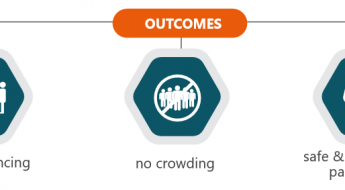
APRON and GATE related applications, products – or in combination solutions – have conventionally been installed in relatively encapsulated environments. The solution got defined, often tailored for a specific airport under the “we are different” paradigm, installed and … frozen. Sticking to the encapsulated system environment, this has not necessarily been a “worst choice”-scenario. Many solutions are running this way for more than 15 years, a long time out of the books but still providing 100% performance.
Since then, a lot has changed, and diverse key drivers are calling for innovative ways of working and supporting new business models.
Soft-PLCs
What was frozen for decades in PLC software has moved into computer environments. Those environments are constantly changing, respective 1:1 replaceable hardware is not easily and necessarily available, operating systems get discontinued and with those, not seldom, support of existing drivers of the legacy hardware. Such systems require maintenance today which is beyond typical hardware maintenance.
Degree of integration
To provide operational safety and end-to-end processes, to gain efficiency, to tackle capacity constraints – all this requires a high degree of integration between the different systems on the apron. Every stakeholder needs to know about the others’ “who?”, “when?” and “hows?”, but also about their challenges, delays, technical issues, etc. Well known examples include the headache wrong baggage routing can create. Not only the solution delivered by your own, but also all other solutions are subject to constant change which one needs to adapt to for guaranteeing end-to-end value for the customer. This shows again: stand-alone Software as a Product one-time deliveries will not easily cope with the future. And, as many customers are confirming, lean operations during COVID times are showing how disconnected systems still are.
Data security
Subsequently, the higher the degree of integration the more challenging the security setup becomes. Initially delivered with isolated, even physically isolated networks, blocked communication ports etc., solutions today need to publish and subscribe information. For example, the passenger boarding bridges publish the bridge status and position for the A-VDGS Safedocks, the AODB provides new flight schedules to the Safedocks, and the Safedock speaks to the Airfield Ground Lighting for switching the lead-in lights. And those are only examples from one manufacturer’s portfolio; there are many more stakeholders out there. Thus, stakeholders need to keep their solution security-wise up to date but even continuously need to collaborate with all parties to also cover the gaps in between the solutions.
Operational Safety
Besides the efficiency gains integration is bringing, the term of operational safety has been prevailing in daily discussions. Simplified, it can be seen as “making the turnaround of an aircraft smooth”. This requires integration as already described. But it also requires the elimination of uncertain variables in the entire chain. Interestingly, in the past, risks have been mitigated on airports often with adding more people. Now, it is common understanding that technical solutions with end-to-end capability drive operational safety (and digitization). Consequently, suppliers cannot purely develop tools related to their individual portfolio in isolation (as a Product) but have, due to the increased demand for integration, up to 30% interfacing costs which require maintenance over its entire lifetime.
Partnering and embedded services
Towers, Apron Towers and AOCCs are full of screens today, with a growing tendency. Solutions are created – such as the Safecontrol Apron Management (SAM) or even more inclusive solutions such as OneControl – to merge multiple frontends into one. Other examples are Artificial Intelligence (AI) solutions hooking on existing data streams and providing complementary information feed-back into the application (one might call it an app). Providing a huge benefit to the end-user with proven value for the customer, this leads to a fluid ecosystem of dependent applications which need to develop in an aligned manner. This gets even more challenging with heterogeneous suppliers. The same exact solution delivered 15 years ago in a “as a product manner” is certainly not the one following this path.
ADB SAFEGATE has followed the market developments and operational requirements since two decades now, setting market trends and de-facto standards together with the customers.
Having initially supplied the software as a product (as the entire industry has done), ADB SAFEGATE has adapted over time to IT Infrastructure Library (ITIL) and IT Service Management (ITSM) processes to professionally cope with the growing number of change requests required to mitigate the challenges mentioned above. Those ITIL/ITSM processes embedded in an SLA to maintain a deployed “as a product”-solution is potentially to most frequently met setup at airports still today.
The “OnPrem Subscription Model
Newly released, ADB SAFEGATE GATE solutions will also be available as an OnPrem Subscription model. To be clear as many words are used as synonyms in that context, it allows to run the solution on customer IT, based on a recurring fee, including upgrades to the latest release available, (disseminating the experience of the huge customer base), as well as services to keep the solution highly available. Thus, it is much more than a license. It provides commercial flexibility during the current challenging COVID times. At the same time it technically allows to stay on the latest solution as well as to continue the established way of working at the customer side with regards to processes such as integration tests, FATs, SATs, stress tests, etc. Changing the procedural context at airports can be by far more challenging then introducing technical innovation which makes the “OnPrem Subscription Model” the logical nearby step.
Where does this transition go? There is a natural path where onPrem solutions migrate into: Software as a Service (SaaS) models. This is because particularly here providers and customers can benefit from the efficiency gains of running several customers in a homogeneous environment, commercially as well as risk-free. Furthermore, in making the solution available for airlines and concession holders of airports, i.e., geographically spread assets belonging to the same customer, performance can be made available via the cloud at the customers location(s), moved and scaled on a button click. This can be technically beneficial but even legally required for certain kind of data.
The ADB SAFEGATE GATE team has just released its statistics and analytics module for its GATE Solution suite in a “SaaS” manner and has successfully deployed it to several international customers. It is installed by ADB SAFEGATE being the supplier, hosted by the supplier, maintained by the supplier, hence the supplier has made the solution available “as a service”.
The technical inside of the cloud solution of the future will be the same for both, onPrem or aaS. Developed for cloud technology, already today customers run the ADB SAFEGATE GATE solution in their private geo-spatially distributed data-centers providing an airport specific cloud. At the same time others run the solution on our public cloud space during project execution before migrating it into its final productive environment.
ADB SAFEGATE provides integrated solutions that raise efficiency, improve safety, boost environmental sustainability and reduce operational costs for airports, airlines and ANSPs. The company works with airports and airlines to solve operational bottlenecks from approach to departure. Solutions encompass airfield lighting, tower-based traffic control systems, intelligent docking automation and services, as well as applying advanced IT and analytics to deliver industry-leading Total Airport Management. For more information about ADB SAFEGATE, please visit our website at adbsafegate.com.















Leave a Comment